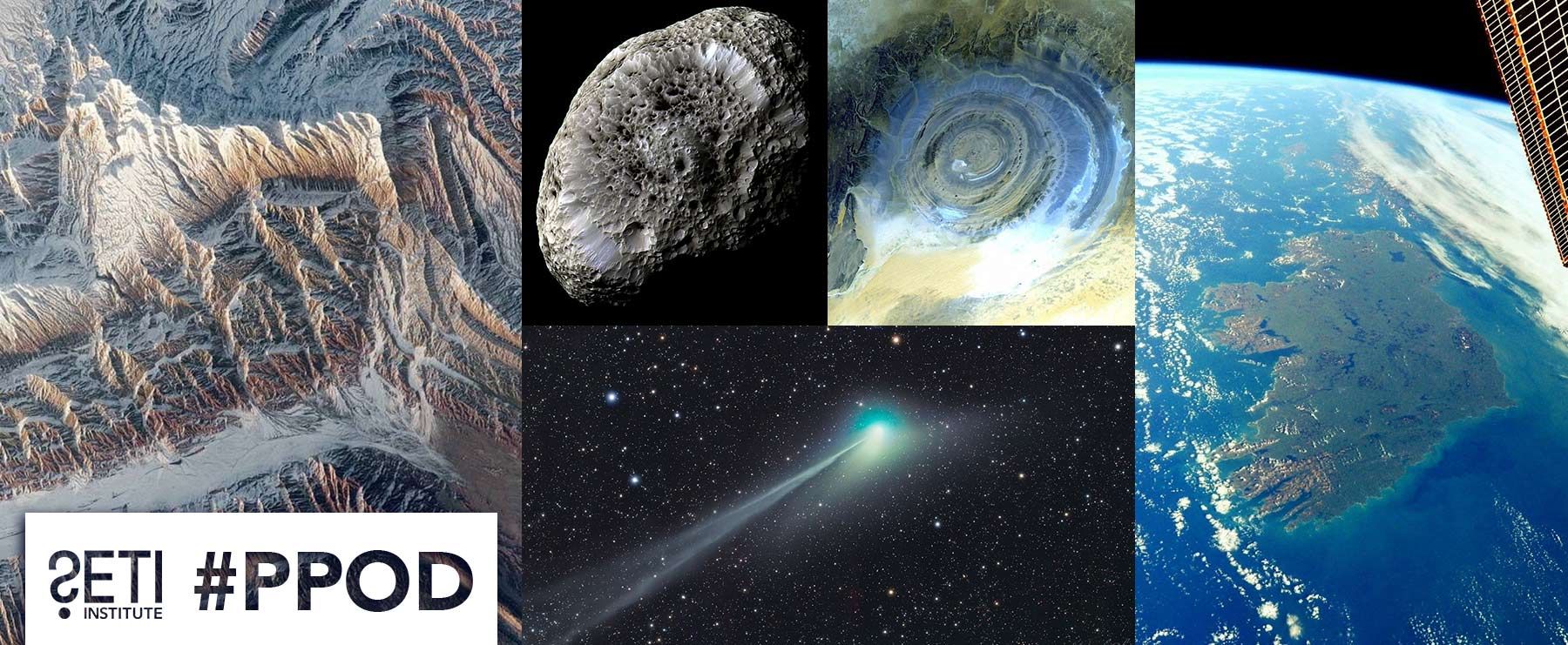
Planetary Picture of the Day
Week of January 23, 2023
Amazing features on Earth, a comet in the night sky, and Saturn's moon Hyperion.
Monday, January 23, 2023

Credit: NASA
Snowy Celestial Mountains
Snow and ice cover mountains of the Tien Shan range in this photograph taken from the International Space Station (ISS) on Feb. 9, 2022. The Tien Shan—which means heavenly mountains in Chinese—is one of the largest mountain ranges in the world, extending approximately 2,500 kilometers across Central Asia, mostly along the border between Kyrgyzstan and China. The glaciers covering these slopes are a crucial source of water for nearby farmers and residents.
Tuesday, January 24, 2023

Credit: Miguel Claro Astrophotography | Reserva DARK SKY Alqueva
Comet c/2022 E3 ZTF
The image shows a close-up view of Comet c/2022 E3 (ZTF) during 19th January 2023. Besides featuring a wonderful greenish coma from glowing carbon gas and rare anti-tail, something unusual was happening with the long ion tail, what is called a disconnection event. A piece of Comet ZTF’s tail has been disconnected and is being carried away by the solar wind. The comet was photographed late in the night at a distance of 79 million Km from Dark Sky® Alqueva Observatory in Portugal, three hours before starts the astronomical twilight.
Wednesday, January 25, 2023

Credit: NASA/GSFC/MITI/ERSDAC/JAROS, and U.S./Japan ASTER Science Team
Richat Structure, Mauritania
This prominent circular feature in the Sahara desert of Mauritania has attracted attention since the earliest space missions because it forms a conspicuous bull's-eye in the otherwise rather featureless expanse of the desert. Described by some as looking like an outsized ammonite in the desert, the structure (which has a diameter of almost 50 kilometers) has become a landmark for shuttle crews. Initially interpreted as a meteorite impact structure because of its high degree of circularity, it is now thought to be merely a symmetrical uplift (circular anticline) that has been laid bare by erosion. Paleozoic quartzites form the resistant beds outlining the structure.
This image was acquired on October 7, 2000 by the Advanced Spaceborne Thermal Emission and Reflection Radiometer (ASTER) on NASA's Terra satellite. With its 14 spectral bands from the visible to the thermal infrared wavelength region, and its high spatial resolution of 15 to 90 meters, ASTER will image Earth for the next 6 years to map and monitor the changing surface of our planet.
Thursday, January 26, 2023

Credit: NASA/Astronaut Terry Virts
Ireland from Space
NASA astronaut Terry Virts tweeted this photo of Ireland taken on the International Space Station on March 17, 2015, in honor of St. Patrick's Day. The Emerald Isle includes several stunning geologic features, including the Cliffs of Moher to the west and the Giant's Causeway in Northern Ireland.
Friday, January 27, 2023

Credit: NASA/JPL-Caltech/Space Science Institute
Hyperion, Moon of Saturn
Hyperion is the largest of Saturn's irregular, nonspherical moons. Hyperion's mean radius is 135 kilometers, but since Hyperion is rather potato-shaped, its shape can be described in terms of its diameter along its three axes: 410 x 260 x 220 kilometers. Considering its odd shape, Hyperion is probably a remnant of a larger moon that was destroyed by a major impact.
This stunning false-color view of Saturn's moon Hyperion reveals crisp details across the strange, tumbling moon's surface. Differences in color could represent differences in the composition of surface materials. The view was obtained during Cassini's close flyby on Sept. 26, 2005.





